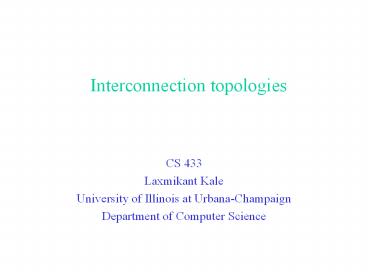Interconnection topologies - PowerPoint PPT Presentation
Title:
Interconnection topologies
Description:
To make a hypercube of degree k, Take 2 hypercubes of degree (k-1) ... N-dimensional 'hyper' cube, but number of processors along each dimension is k ... – PowerPoint PPT presentation
Number of Views:267
Avg rating:3.0/5.0
Title: Interconnection topologies
1
Interconnection topologies
- CS 433
- Laxmikant Kale
- University of Illinois at Urbana-Champaign
- Department of Computer Science
2
Distributed memory m/cs
We discussed the communication interface (Ch 7)
PE0
PE1
PEp
Mem0
Mem0
Memp
Interconnection Network
Now, let us talk about the network topology
3
Topology requirements
- Must connect each processor to all others
- I.e. it should be possible to send messages
between any pair of processors - Desirable
- Intermediate routing, if needed, should happen
without interfering with computation on
intermediate nodes. - Example ring (of theoretical interest only).
4
Topology metrics
- What makes one topology better than other?
- What should we measure?
- What can we measure?
- C the number of connections (degree) per node
- How densely is the graph connected?
- Metric Diameter of the graph
- Others?
- How much bandwidth is available?
- Store-and-forward vs. circuit switched
- Number of independent wires
- Bisection bandwidth
- Divide the set of processors in two equal
partitions - How much data can flow from one partition to the
other (per unit time)? - Take the minimum of this quantity over all
possible partitionings - (If all processors were to exchange data with
random others, ..)
5
Ring just to check our definitions
- Let B be the bandwidth of each link
- C2, D P/2, bisection BW 2B
- If every processor wanted to send b bytes to
every other.
6
Grids
- 2D and 3D grids
7
Hypercubes
- Definition (recursive)
- To make a hypercube of degree k,
- Take 2 hypercubes of degree (k-1)
- Connect the cooresponding processors from each
set (with 1 extra link) - Base case one processor
- Number of processors must be a power of 2
- C log(P)
- Diameter log(P)
- Neighbors?
- Number processors, 0 to P-1, and consider their
binary representation - My neighbor in dimension A is obtained by
flipping my Ath bit.
8
Grids vs Hypercubes
- Is there any disadvantage to hypercubes?
- Seem perfect log P connections, log P diameter
- Wire length
- Why does it matter?
- Signal speed, bandwidth per link (B)
- Grids wires can be very short
- Hypercubes wire length of the same order as the
size of machine - Some wires must cross almost the entire physical
extent - So, grids are the current choice
- Is there an alternative that combines advantages
of both?
9
K-ary n-cube
- Disadvantage of hypercube?
- Wire lengths? May span the entire machine
- Leads to reduced bandwidth per link
- Number of connections per node increases with the
size of the machine - K-ary ncube allows one to seek intermediate
points between grids and hypercubes. - N-dimensional hyper cube, but number of
processors along each dimension is k (instead of
2 of binary hypercube)
10
Trees
- Tree as a topology
- branching factor C-1 (except at root C)
- depth log P (to the base C-1)
- diameter 2depth
- Problem?
- Bisection bandwidth
- Bottleneck near root
11
Fat Trees
- If we need more bandwidth as we go near the root
- Add more parallel links as we go up the tree
- Switch complexity?
- Used in the connection machine
12
Dense graphs
- Moore bound
- 3 optimal configurations exist
- P10, C 3
- Other 2?
13
Tree-on-tree
- Two identical trees, with leaves connected to
each other. - No one uses it why?
14
Dense graphs
- Moore bound is much tighter than hypercube
- Constant connections, log P (base C-1) diameter
- 1024 processors
- hypercube diameter 10
- Moore bound on diameter with C10 is 4.
- Random graphs are dense
- Specially constructed graphs
- Utility?































